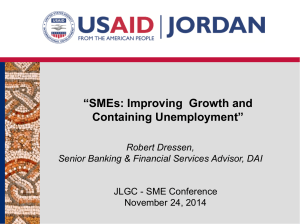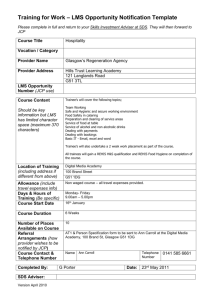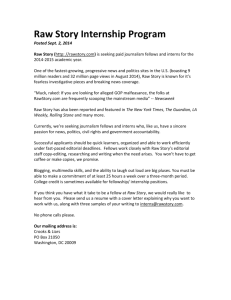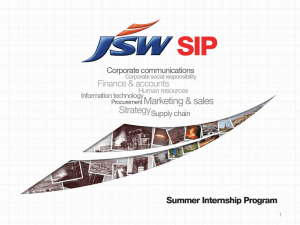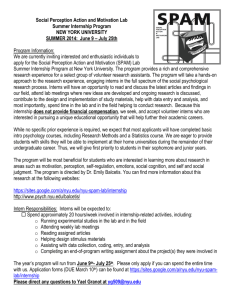PowerPoint Presentation - Jordan Competitiveness Program (JCP)
advertisement
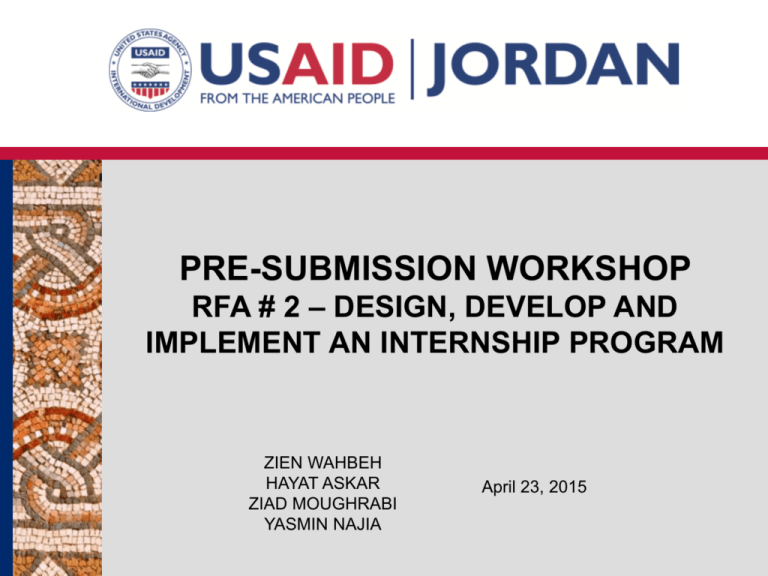
PRE-SUBMISSION WORKSHOP RFA # 2 – DESIGN, DEVELOP AND IMPLEMENT AN INTERNSHIP PROGRAM ZIEN WAHBEH HAYAT ASKAR ZIAD MOUGHRABI YASMIN NAJIA April 23, 2015 JORDAN COMPETITIVENESS PROGRAM 2 ABOUT JORDAN COMPETITIVENESS PROGRAM Is a five year USAID-funded program implemented by Development Alternatives, Inc. The program started in October 2013 and focuses on increasing competitiveness of the Jordanian market by creating new jobs, increasing foreign direct investments, increasing exports, engaging diaspora, empowering angel networks, etc.). The program will be implemented through its four major components: 1.Supportive Enabling Environment (SEE) 2.Workforce Development (WFD) 3.Cluster Development (CD) a) Clean Technologies (Water, Energy and Environment) b) Health Care and Life Sciences c) Information and Communications Technology (ICT) 4. Access to Finance (ATF) 3 PRE-SUBMISSION WORKSHOP AGENDA 10:30 AM – 10:45 AM: Welcome and Introduction to JCP 10:45 AM – 11:45 AM: RFA Technical Program Description 11:45 AM- 12:00 PM: Coffee Break 12:00 PM – 12:30 PM: M&E and Branding and Marking Requirements 12:30 PM – 1:30 PM: RFA Grants Eligibility and Financial Requirements 4 RFA OUTLINE 5 RFA SECTIONS Section A: Grant Application Instructions: I. Completion and Submission of Applications II. Preparation Instructions – Technical III. Preparation Instructions – Financial and Administrative Documentation Section B: Special Grant Requirements Section C: Selection Process Section D: Program Description Annex 1: Mandatory Standard Provisions Annex 2: Application Form Annex 3: Bio Data Form Annex 4: Financial Capability Questionnaire Annex 5: Instructions for Obtaining a DUNS Number Annex 6: Self Certification for Exemption from DUNS Requirement Annex 7: Quick Start Guide for Entities Interested in Being Eligible for Grants Annex 8: Application Check List 6 THE TECHNICAL OVERVIEW 7 PREPARATION INSTRUCTIONS – TECHNICAL Applications must include the following information: 1. Project Description Brief Statement of Purpose/ Project Summary Background and Expected Results Project Goals and Objectives 2. Project Team Project Manager Project Coordinator Trainer 3. 4. 5. 6. Organizational Capability and Resources Past Performance Budget: Detailed budget with notes and partnerships – if any Other Material/ Annexes 8 PROGRAM DESCRIPTION • Increase exposure for 750 recent graduates and senior under graduates to the requirements of work through internship opportunities • Increase employment opportunities, especially for women, in USAID/JCP target sectors within three months to six months of internship to be hired at the same hosting organization or other organizations within JCP targeted sectors; and • Increase workforce readiness in USAID JCP key sectors 9 SPECIFIC TASKS AND RESPONSIBILITIES… (1) Phase I: Program Design and Development • • • • • Define potential partners (implementers of the internship program). Define the existing internship opportunities and the need of employment in the specific sectors; vacancies available and qualifications needed taking into consideration students’ summer break for this year, Ramadan and the upcoming holidays. Develop the program approach. Network and establish partnership agreements with private sector to place interns. Establish partnership agreements with universities and youth organizations to recruit and select interns. 10 SPECIFIC TASKS AND RESPONSIBILITIES…(2) Phase II: Implementation • Develop a comprehensive approach to assure the proper execution of the internship program. • Take into consideration the following characteristics in designing the internship program: First: Target Segment • Completed 3rd or 4th year of study. Senior & recent graduates • Within JCP targeted sectors (CT, ICT, HLS) • 25-50 % women or outside Amman 11 SPECIFIC TASKS AND RESPONSIBILITIES…(3) Second: Compensation: 250 intern first year and 500 interns second year Category Salary (JDs) Period Undergraduate 120 2 months Recent Graduate 220 3 months Grantee Salary contribution Inside Amman Outside Amman First Year 50% 25% Second year 75% 50% 12 SPECIFIC TASKS AND RESPONSIBILITIES…(4) 1.Contact relevant sector associations and organizations to submit expressions of interest 2.Prepare clear Scopes of Work for Interns 3.Allocate mentors for interns or supervisors to provide guidance 4.Conduct (graduation ceremony) at the completion of the internship program. 13 SPECIFIC TASKS AND RESPONSIBILITIES…(5) Third: Partnership Establish non-traditional partnerships (consortiums) that contribute materially to the quality of the internship experience Fourth: Duration 3 months for recent graduates 2 months for senior undergraduates Overall Performance of the Grant is 24 months. The completion date of placement should be within 18 months, the remaining 6 months for reporting, evaluation and monitoring outcomes and following up with the last batch on placed interns. 14 SPECIFIC TASKS AND RESPONSIBILITIES…(5) Fifth: Location • Opened for all university students and graduates. • Placements are open for all governorates. • 25-50 % of placed interns should go to women and/or hosted outside Amman. Sixth: Training Minimum of 2-day training. One day before starting the internship and explains employability skills. Second day topics are open for grantee suggestions within the area(s) of need. 15 SPECIFIC TASKS AND RESPONSIBILITIES…(5) Seventh: Quality Control Applicants to propose a detailed plan for how they will address issues of quality control – regularly following up with interns during the internship program through phone calls and diagnostic visits or any other innovative mechanisms as deemed appropriate. Eighth: KAFD CGOs Engagement JCP encourages applicants to engage the KAFD Career Guidance Offices (CGOs) at universities to recruit interns, spread awareness of the internship program and involve them in quality control monitoring. 16 SPECIFIC TASKS AND RESPONSIBILITIES…(5) Phase III: Evaluation and Feedback a.Design and implement surveys to assess the satisfaction of the interns and the hosting organizations b.Submit Quarterly Reports and a final report Database of interns and hosting organizations Results of the conducted surveys Lessons learned and recommendations for further internship program improvements Training reports, topics, content, trainers, and evaluation results c. Follow up with interns three and six months after the completion of the program. By the end of the six-month follow up surveys, the grantee should reach a placement rate of at least 75% among graduate participants at their hosting organizations or another within the JCP target sectors. 17 SPECIAL CONSIDERATION • Interns and companies selections should be in JCP specific sectors (CT, ICT, HLS). • Grantee(s) are encouraged to seek partnership and sponsorships to cover the expenses incorporated in the internship programs such as salaries, training, graduation ceremony etc. of the participating interns. Grantees are encouraged to be very innovative in utilizing the fund requested. • The hosting organizations should have actual need of hiring to assure real placements after completing the internship period. 18 PREPARATION INSTRUCTIONS – TECHNICAL Page Limitation: Applications should be specific, complete, presented concisely and shall not exceed 50 pages (exclusive of annexes). 19 M&E REQUIREMENTS 20 WHAT M&E TOOLS? • M&E Plan • Post-event report • Impact assessment reports 21 HOW TO BUILD YOUR M&E PLAN? 1. Understand JCP Results Framework 2. List your Workplan activities at the bottom of the M&E plan template (Workplan Template) – Remember the resources 3. Set short-term and long-terms results for each (outputs and outcomes) 4. Add your baseline, targets, units of measurement and reporting frequency 5. All that should lead you to overall goals and results identified in the application form (section II.3) 22 HOW TO BUILD YOUR M&E PLAN? 1. Understand JCP Results Framework 2. List your Workplan activities at the bottom of the M&E plan template (Workplan Template) – Remember the resources 3. Set short-term and long-terms results for each (outputs and outcomes) 4. Add your baseline, targets, units of measurement and reporting frequency 5. All that should lead you to overall goals and results identified in the application form (section II .3) 23 JCP OBJECTIVES Private Sector Competitiveness Increased Technica l Assistance: Fina ncial Assista nce: Direct Assistance from JCP Assistance from other financial Institutions – Start up – Enhancement of existing – Export Development – Investment Readiness – Angel Investment Workforce Enha ncement: Internships Centers of Excellence Support Curriculum Development Trainings Associations Companies Diaspora Entrepreneurs Sector-Landscape Assistance: Policy regulations and Regulatory reforms Awareness Networking and Linkages Dialogue Facilitation Innovation Landscape 24 New Jobs 25 JCP RESULTS FRAMEWORK DO 1: Broad-based inclusive economic growth accelerated IR 2 Workforce development and opportunities for vulnerable groups increased Outputs Outcomes Sub IR 2.1 Curriculum integrating market demands and job skills of target groups improved -Career development centers established to help Jordanians gain the skills they need to succeed in the private sector -A National ICT Excellence Center Established -University Curricula in Targeted Sectors Match Market Demand -Internship programs strengthened - COEs established / upgraded -ICT SSO established + operational - # of participant members in ICT SSO - # of students completing CDC/KAFD training programs - # of track specialization program identified -# of universities/ colleges identifying & impl. the program -# of internships placed annually Sub IR 2.5 Sub IR 2.2 Gender & age-based legal & Entrepreneurship opportunities regulatory barriers & practices promoted, especially for women to economic resources & rights in the SME sector reduced -An Increase In the Number of High Quality Courses on Entrepreneurship, Innovation and Competitiveness in Jordanian Universities - # of courses added to University curriculum - # of students completed courses listed in indicator 6 -Increase Participation of Women in the Workforce Supporting JCP Target Sectors -Situation mapped and activities to contribute to better women participation agreed on 26 HOW TO BUILD YOUR M&E PLAN? 1. Understand JCP Results Framework 2. List your Workplan activities at the bottom of the M&E plan template (Workplan Template) – Remember the resources 3. Set short-term and long-terms results for each (outputs and outcomes) 4. Add your baseline, targets, units of measurement and reporting frequency 5. All that should lead you to overall goals and results identified in the application form (section II .3) 27 1. List your Workplan activities at the end of the logframe / plan template (Workplan Template) 28 Workplan Template 29 HOW TO BUILD YOUR M&E PLAN? 1. Understand JCP Results Framework 2. List your Workplan activities at the bottom of the M&E plan template (Workplan Template) – Remember the resources 3. Set short-term and long-terms results for each (outputs and outcomes) 4. Add your baseline, targets, units of measurement and reporting frequency 5. All that should lead you to overall goals and results identified in the application form (section II .3) 30 Set short-term and long-terms results for each (outputs and outcomes) • # of applications • # of available posts • # of interns Number of persons receiving internship as a result of participation in USG workforce development programs Long and short term • # of jobs Outcomes and Outputs are now ready 31 HOW TO BUILD YOUR M&E PLAN? 1. Understand JCP Results Framework 2. List your Workplan activities at the bottom of the M&E plan template (Workplan Template) – Remember the resources 3. Set short-term and long-terms results for each (outputs and outcomes) 4. Add your baseline, targets, units of measurement and reporting frequency 5. All that should lead you to overall goals and results identified in the application form (section II .3) 32 4. Add your baseline, targets, units of measurement and reporting frequency 33 HOW TO BUILD YOUR M&E PLAN? 1. Understand JCP Results Framework 2. List your Workplan activities at the bottom of the M&E plan template (Workplan Template) – Remember the resources 3. Set short-term and long-terms results for each (outputs and outcomes) 4. Add your baseline, targets, units of measurement and reporting frequency 5. All that should lead you to overall goals and results identified in the application form (section II .3) 34 LOGICAL FRAMEWORK LOGIC: 35 5. All that should lead you to overall goals and results identified in the application form (section II .3) 36 Post-event report to be submitted upon completion of the activity should include: a summary about the activity details about hosting companies and the interns their full contact information, location, gender, university, etc.) a section about participants’ (interns and companies) feedback, lessons learned and ideas for improvement 37 Impact assessment reports to be submitted three times: Baseline three months six months after the program to show the jobs that were created as a result of the program. 38 THINGS TO TAKE INTO CONSIDERATION WHEN DEVELOPING THE M&E PLAN • Is there any need for special data collection, special studies, or any additional work specially for M&E? Is it reflected in the budget? • Make sure you assign someone from the project implementation team to do the M&E part of the project • Assess your staff’s capacity for M&E tasks. Reflect needs for capacity development in your M&E Plan. • Disaggregation: Results should be aggregated among others to geography, sub-cluster, gender, etc. • On-site monitoring visits by the USAID JCP project team will be conducted after the grant agreement BRANDING AND MARKING 40 Branding and Marking • The Grantee is free to copyright any books, publications, or other copyrightable materials developed in the course of or under this award, but USAID reserves a royalty-free nonexclusive, and irrevocable right to reproduce, publish, or otherwise use, and to authorize others to use the work for government purposes. • The Grantee should mark any developed curricula, studies, reports, papers, training materials or any other publications with the USAID JCP Identity • The USAID JCP logo should be displayed in the upper left side of any developed publications 41 Branding and Marking • The Grantee should mark any event related to the RFA with the USAID JCP Identity. such as training courses, conferences, seminars, exhibitions, workshops, press conferences and other public activities • When implementing any event as mentioned before, the should use USAID JCP roll-ups in the venue, and all the hand-out materials should be branded with USAID JCP Identity • The COR may require the USAID Identity to be larger and more prominent if it is the majority donor 42 Branding and Marking • The Grantee may use its own logo on the developed materials in the right side of the developed materials upon written approval from USAID JCP • The COR may require a pre-production review of USAID-funded materials for compliance with the approved Marking Plan. • The Grantee should provide the USAID JCP personnel designated with two copies of all the materials produced under the agreement. 43 Branding and Marking • The Grantee may request program deliverables not be marked with the USAID Identity by identifying the program deliverables and providing a rationale for not marking these program deliverables. • The Grantee should have the approval of USAID on any press materials before send to the press 44 Branding and Marking • Any ‘public communications, in which the content has not been approved by USAID JCP, must contain the following disclaimer: “This curricula/study/report/audio/visual/other information/media product (specify) is made possible by the generous support of the American people through the United States Agency for International Development (USAID). The contents are the responsibility of [Grantee] and do not necessarily reflect the views of USAID or the United States Government.” 45 APPLICATION SUBMISSION 46 APPLICATION SUBMISSION REQUIREMENTS Application must be: • Submitted by email and hand-delivered • Submitted in both hard copy and electronic form • Submitted in one original (with attachments) and four copies (without attachments) and include: Completed Application Form Completed Project Workplan Projected Grant Budget and Budget Notes CVs and Bio Data forms of all project team members Completed Financial Capability Questionnaire and attachments Statement of liability (part of application form) 47 APPLICATION SUBMISSION REQUIREMENTS Deadlines Applications must be received by Wednesday May 13, 2015 at 4:00pm Applications and modifications shall be submitted in pdf (preferred) and electronic format to the JCP Competitiveness Partnership Fund Team by email to JCPGrants@dai.com with hard copies sent to the following address: Competitiveness Partnership Fund Team USAID Jordan Competitiveness Program King Hussein Business Park, Building 3, Ground Floor Amman, Jordan Late Applications Applications which are submitted late or are incomplete run the risk of not being considered in the review process. 48 PREPARATION INSTRUCTIONS – FINANCIAL AND ADMINISTRATIVE DOCUMENTATION 1. Completed Budget 2. Completed Financial Capability Questionnaire 3. Documentation of existing commitments (documents may include certification from the applicant’s bank or a summary of previous awards, including type of funding value, client). A separate bank account is required should an award be made. 4. Documentation that the applicant has a record of integrity and business ethics (reference from donors would suffice) 5. Each applicant should provide (as annexes) the following: If applicable – NICRA if unavailable, the profit and loss statement Cash flow, management structure Copy of applicant’s accounting and operations manual Copy of purchasing policies and description of applicant’s system (for large grantees). 49 SELECTION PROCESS 50 SELECTION PROCESS • Within ten working days of the deadline, a review panel will convene and will include JCP senior management and technical experts • Applications will be initially screened for completeness by the JCP CPF team • One award will be made within 60 working days of the review panel meeting provided that the awardee furnishes DAI with all required documentation in section A of this RFA • Award will be made to responsible applicants whose applications offer the best value 51 EVALUATION CRITERIA 1. Project Description (40 points broken down as follows: Statement of Purpose/ project summary (4points) Background and expected results (6 points) Project goals and objectives (6 points) Detailed description of project activities/ workplan (6 points) Beneficiaries (6 points) Monitoring and Evaluation (6 points) Sustainability (6 points) 2. Project Team (20 points) 3. Organizational capabilities and past performance (20 points) 4. Project Budget (20 points) 52 SPECIAL GRANT REQUIREMENTS 53 SPECIAL GRANT REQUIREMENTS • Separate Bank Account • Permitted Uses of Program Income (added to USAID, cost share, reduced from grant award) • Use of Funds • Reporting Procedures: Program report, Final Program report, Financial Reports • Project Monitoring • Restrictions (military, surveillance, abortion, gambling equipment, pharmaceuticals, pesticides, etc.) • Other: Grants will be made available to eligible nongovernmental organizations with a ceiling of USD300,000. Payments will be made in agreement with the awardee but in no case will more than 90% of the total agreed budget be disbursed prior to receiving and approving the Final Financial and Final Program Report. 54 ELIGIBILITY OF ORGANIZATIONS AND ACTIVITIES 55 INELIGIBLE ORGANIZATIONS • • • • • • • • • • Political party organizations and governmental institutions Faith-based organizations whose objectives are discriminatory Organizations from foreign policy restricted countries (Cuba, Iran, North Korea, Sudan and Syria) are not eligible Organizations included in the List of Parties Excluded from Federal Procurements and Non-Procurement Programs are not eligible for awards if they have members who appear in the US Treasury’s List of Specially Designated Nationals and Blocked Persons or who have been designated by the UN as an individual linked to Taliban, Osama Bin Laden or Al Qaeda organization. Any US entity which is a “Private Voluntary Organization (PVO) but has not registered as such with USAID. Any entity whose names appears on the “List of Parties Excluded from Federal Procurement and Non-Procurement Programs” Any “Public International Organization” (PIO) Any foreign government except Jordan Any entity affiliated with DAI or any of its directors, officers, or employees Individuals 56 INELIGIBLE ACTIVITIES • • • • Private ceremonies , parties, celebrations Fundraising Construction activities Promotion of political parties, religion or commercial interests, nor • Other activities deemed to be inherently religious. 57 ELIGIBILITY REQUIREMENTS • • • • • Non-Governmental, non-profit, or profit making organizations Must be a formally and officially recognized or registered in Jordan or in the United States Should have sound business practices such as Equal Opportunity and cannot engage in child labor. If a newly established business, this should appear in the organization’s business plan Support outcomes and results consistent with and linked to JCP’s Intermediate Results (IR) and objectives, support activities within the program’s targeted region(s), and Demonstrate evidence of a significant cost share commitment in most, but not all cases. 58 ELIGIBLE ACTIVITIES SHOULD HAVE: • • • • Clear, definable, achievable objectives Clearly and reasonably planned activities Measurable, realistic, achievable outcomes A sensible timetable, not exceeding the period defined in the RFA. Activities should be linked to JCP objectives and results. 59 ANNEXES OF THE RFA 60 THANK YOU 61
